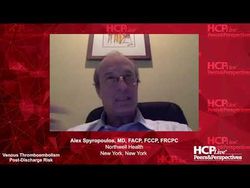Antithrombosis in Patients with COVID-19 - Episode 7
DVT/VTE Prophylaxis Guidelines
Transcript: Gregory Piazza, MD, MS: Now that we’ve had some experience under our belts, what are the current recommendations or guidelines for prevention of DVT [deep vein thrombosis] and PE [pulmonary embolism] in patients with COVID-19 [coronavirus disease 2019]? Different societies have issued guidance on their websites. Obviously, there’s no way you can put together a big guideline document this quickly, but what do you use? What do you recommend those joining us for this conference use as a resource?
Alex Spyropoulos, MD, FACP, FCCP, FRCPC: Greg, first of all, I have to take my hat off to the various cardiology and thrombosis societies that have gone through herculean efforts to produce in 2 weeks what usually would take 6 or 8 months—guidance, or even a guideline document. You and I both worked on a very recent guidance document that was multi-institutional, international, and multidisciplinary. This represents a state-of-the-art summary of what we know at this point, with respect to thrombotic disease management.
I’m actually leading an effort by ISTH [International Society on Thrombosis and Haemostasis] as part of the Scientific Standardization Committee in creating a VTE [venous thromboembolism] document, both for prevention and management. What we see, as Vic was discussing earlier, is a unification and harmonization of all the guidance guideline bodies that, at this point, using the best available evidence, suggest we should recommend routine chemoprophylaxis at the standard doses. Right now, the 1 thing we should do is provide standard-of-care chemoprophylaxis using the standard dosing regimens of either unfractionated heparin—especially if you’ve had elements of renal insufficiency—or low molecular weight heparin, which seems to be the preferred agent. Of course, we should have a low threshold for increasing the dose, especially in obese patients. They seem to get into more trouble in terms of outcomes. I think all the guidance guideline documents advocate for the need for high-quality trials, which is what Vic was talking about.
At the very least, have a method of identifying these patients and prophylaxing them. All the listeners out there, get your patients into these key randomized trials that we’ve been talking about.
Victor Tapson, MD, FCCP, FRCP: One very quick point I’ll add is that these guidelines and documents are great, but they’re going to need to be updated in a couple of weeks or a month if we do the right studies. We enrolled 1000 patients around the world on the remdesivir trial, 1000 patients at 70 centers in a matter of weeks. We enrolled 25 patients at Cedars Sinai in 10 days. My point is, these guidelines are great. They’re going to have to be malleable and updated, because things are changing so fast.
Alex Spyropoulos, MD, FACP, FCCP, FRCPC: I couldn’t agree with you more. In my view, these are living documents. In the COVID-19 era, these have to be updated quite frequently, because this thing is changing by the hour and by the day and by the week. Absolutely.
Gregory Piazza, MD, MS: Absolutely.
Transcript Edited for Clarity



